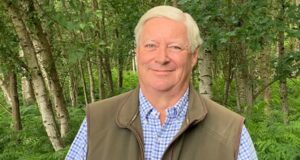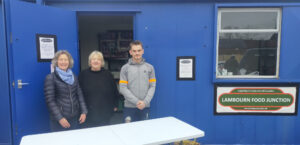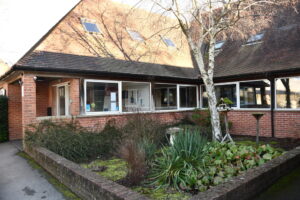
WWII and the use of Ashdown Park
In 1940 after the evacuation of the troops from Dunkirk the Kings Regiment a unit of the Royal Army Service Corps were stationed here while resting, re-equipping and retraining.
Huts were built hidden between the trees on the right of the front drive leading up to the house and also alongside the drive leading from the house towards the present car park. A tree there still has some insulators attached that would have carried electric power or field telephone cables.
In dry weather it is possible to see parch marks on the South Lawn showing the outline of where the Cinema stood and near it another hut. Close beside the drive two thick parallel marks look like a hard-standing or ramp on which a truck could be driven up raising it for maintenance.
In 1941 a Scottish regiment was here and then the 1st Armoured Corps with Sherman Tanks and armoured reconnaissance vehicles. During this period the tank kerbs were added to the entrance drives and the sharp bend just south of the house. These were to help the tanks turn the corners on the roadway and not get stuck in the soft ground either side.
Later on an Airborne unit may have been here for a short time but we do not know which unit.
In 1942 French Canadians were billeted in the house.
During restoration work a few years ago letters and American cigarette packets were found hidden behind the paneling.
In 1943 Ashdown House and Park became Station 544 of the American Eighth Army Airforce and housed a Ground Air Support Unit. This was a Quartermaster Truck Company equipped with large lorries and fuel tankers. During this period a tarmac loop hard-standing was added out in the roadside field which can still be seen today and underground fuel tanks installed.
Recently a section of fuel pipeline surfaced in the field and was removed to avoid injury to grazing horses.
These units had coloured Americans troops with white officers. At that time coloured and white troops did not mix. The officers lived in the House and the coloured troops in the Victorian Stable Block and the farm buildings that are now the Estate Yard.
These troops would have served at Membury, Welford and Ramsbury airfields where the 9th Airforce were operating C47 Douglas Dakota transport aircraft, these also towed Airspeed Horsa and Waco CG4A Hadrian gliders.
At this time a C47 Dakota fuselage was hoisted and secured spanning between two trees in the East Park. It may have been used as a training aid of some sort. The supporting timbers survived for many years but have now rotted away and several small parts of the airframe have been found over the years during tree planting work.
Just to the north of Ashdown between the end of the North Avenue and the Ridgeway an Advanced Landing Ground ALG was laid down at Red Barn. This was constructed using metal tracking as a practice exercise during Operation Spartan. It was constructed in the space of only two days and was good practice for constructing airfields rapidly once France had been invaded
The troops assisted Mr Spence the farmer with his harvest gathering the stoked corn and moving the stacks out of the way before then immediately setting about laying the runway.
It is still possible to trace its course by plotting the wide gaps in the field hedges to the right of the road as you drive from Ashbury towards Ashdown.
North American P51 Mustang fighter aircraft from 26 Squadron flew from the strip for a short period.
Just prior to D-Day a huge practice air drop was carried out on the downs with parachutists and supplies dropped from the air.
It is said a local farmer found a jeep on his land and dismantled a nearby haystack and rebuilt it over the jeep hiding it. He later retrieved the jeep and used it for many years!
Another story was what is called” The Cullinan Incident.” It is said a man was caught up on Weathercock Down. He was observed at the Rubbing House an old brick ruin dating back to when there was a horse racing course up there on the down. The man was seen using a light at night to signal to enemy aircraft. He was captured by soldiers from the Sherwood Forester who were stationed nearby in Lambourn. He was offered a pistol and give the option of taking his own life or to be shot by the troops.

It is said that at the same time a racehorse trainer in Ashbury committed suicide so there may have been some link with Fifth Columnists.
Rumour has it that there was a caravan used as a house of ill repute between Ashdown and Lambourn where young ladies provided comfort for the troops. Children remember finding a great many uniform buttons in the surrounding field.
Lambourn of course was heavily occupied by the 501st Parachute Infantry Division with units of the US 101st Airborne the “Screaming Eagles “. They have recently been portrayed through the film The Saving of Private Ryan and The Band of Brothers TV series.
Over the years we have unearthed several items from the period of military occupation.
- A Canadian cruciform section bayonet
- Bazooka anti tank projectile rockets
- A mess tin marked US Army
- Knife, fork and the spoon
- A Rolls Royce Merlin aircraft exhaust stub
- Glass vials which contain a white powder which may have come from a First Aid kit. They have a scored band around them where they can be snapped in two to release the contents.
- .303 and .50 ammunition cartridges
- Morter fins
- Small parts of C47 Dakota
- Sections of Tortoise Hut Stoves
- Aircrew oxygen mask
- Bomb casing
- Cup with NAFFI crest
- RASC spoon with service number 564456
- Base of Radio Direction Finder RDF loop from C47
- Belt buckle
- Small brass protractor
- Brylcream jar
- Jeep screwdriver
- US Army button
- Drug bottle
- Hampshire Fire Brigade button
Keith Blaxhall (Ashdown Estate Office)




